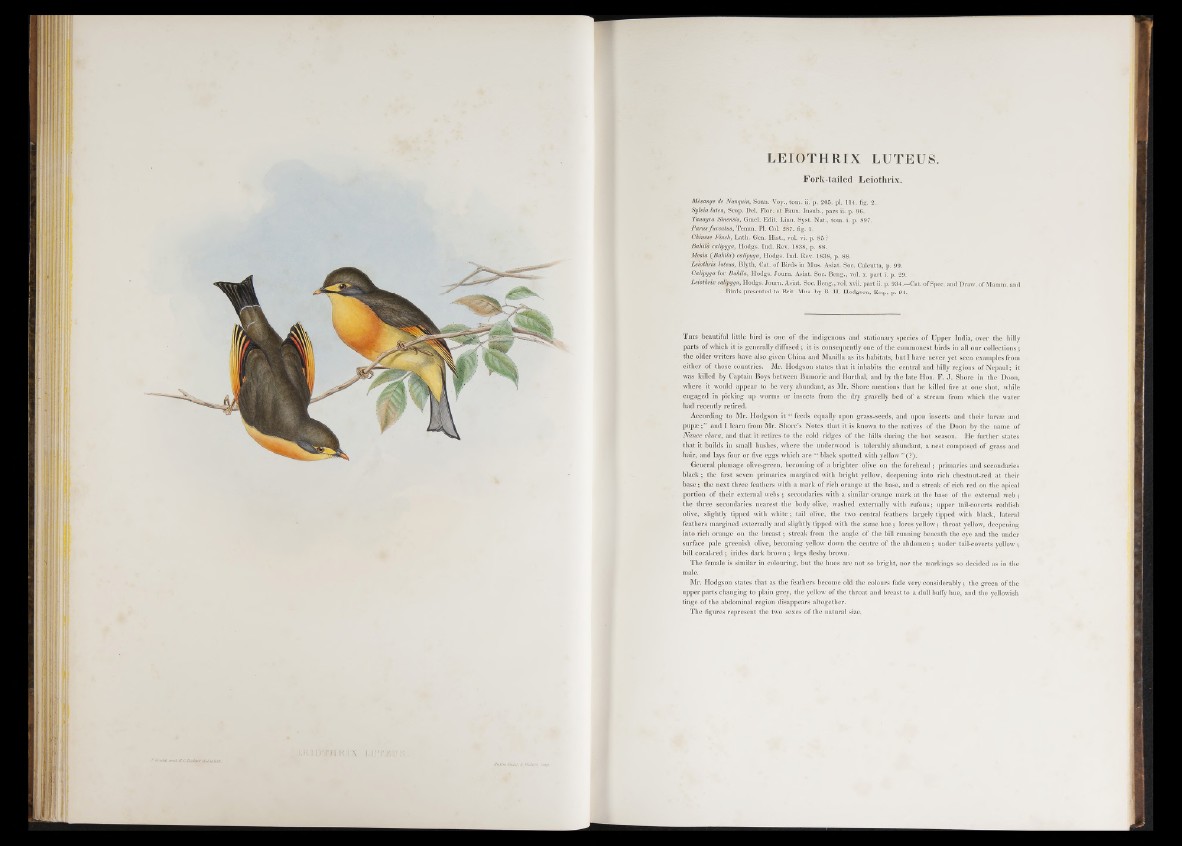
LEIOTHRIX LUTEUS.
Fork-tailed Leiothrix.
Mésange de Nanquín, Sonn. Voy., tom. ii.'p. 205. pi. 114. fig. 2..
Sylvia lutea, Scop. Del. Flor, et Faun. Insub., pars ii, p. 96.
Tanagra Sinensis, Gmel. Edit. Linn. Syst. Nat., tom. i. p. 897.
Parus furcatus, Temm. PI. Col. 287. fig. 1.
Chinese Finch, Lath. Gen. Hist., vol. vi. p. 85 ?
Bahila calipyga, Hodgs. Ind. Rev. 1838, p. 88.
Mesia (Bahila) calipyga, Hodgs. Ind. Rev. 1838, p. 88.
Leiotbr'vs luteus, Blyth, Cat. of Birds in Mus. Asiat, Soc. Calcutta, p. 99.
Calipyga for Bahila, Hodgs. Journ. Asiat. Soc. Beng., vol. x. part i. p. 29.
Leiothrix calipyga, Hodgs. Journ. Asiat. Soc. Beng., vol. xvii. part ii. p. 934.—Cat. of Spec, and Draw, of Mamm. and
. Birds presented to Brit. Mus. by B. H. Hodgson, Esq., p. 94.
T h is beautiful little bird is one of the indigenous and stationary species of Upper India, over the hilly
parts of which it is generally diffused ; it is consequently one of the commonest birds in all our collections;
the older writers have also given China and Manilla as its habitats, but I have never yet seen examples from
either of those countries. Mr. Hodgson states that it inhabits the central and hilly regions o f Nepaul; it
was killed by Captain Boys between Bumorie and Burthal, and by the late Hon. F. J . Shore in the Doon,
where it would appear to be very abuudant, as Mr. Shore mentions that he killed five at one shot, while
engaged in picking up worms or insects from the dry gravelly bed of a stream from which the water
had recently retired.
According to Mr. Hodgson it “ feeds equally upon grass-seeds, and upon insects and their larvse and
p u p a e a n d I learn from Mr. Shore’s Notes that it is known to the natives of the Doon by the name of
Nance chura, and that it retires to the cold ridges of the hills during the hot season. He further states
th at it builds in small bushes, where the underwood is tolerably abundant, a nest composed of grass and
hair, and lays four or five eggs which are “ black spotted with yellow ” (?).
General plumage olive-green, becoming of a brighter olive on the forehead ; primaries and secondaries
b lack ; the first seven primaries margined with bright yellow, deepening into rich chestnut-red a t their
base; the next three feathers with a mark of rich orange at the base, and a streak of rich red on the apical
portion of their external webs; secondaries with a similar orange mark at the base of the external web ;
the three secondaries nearest the body olive, washed externally with rufous; upper tail-coverts reddish
olive, slightly tipped with w h ite ; tail olive, the two central feathers largely tipped with black, lateral
feathers margined externally and slightly tipped with the same h u e ; lores yellow; throat yellow, deepening
into rich orange on the b re a s t; streak from the angle of the bill running beneath the eye and the under
surface pale greenish olive, becoming yellow down the centre of the abdomen ; under tail-coverts yellow;
bill coral-red ; irides dark brown ; legs fleshy brown.
The female is similar in colouring, but the hues are not so bright, nor the markings so decided as in the
male.
Mr. Hodgson states that as the feathers become old the colours fade very considerably; the green o f the
upper parts changing to plain grey, the yellow of the throat and breast to a dull buffy hue, and the yellowish
tinge of the abdominal region disappears altogether.
The figures represent the two sexes of the natural size,